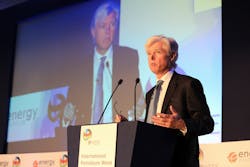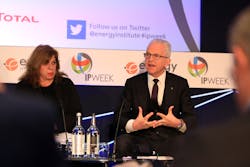Majors, independents champion gas, carbon capture for energy transition
London conference explores creative approaches to tackling emissions
Gas will have a major role to play in the pursuit of lower-carbon energy, according to senior executives speaking at the recent IP Week 2020 conference in London, organized by the Energy Institute. Despite the steady ascent of renewable energy - in certain cases to power offshore production - gas remains the cleanest option, many stressed, to meet the needs of the developed and developing worlds.
Earlier this year BP’s new CEO Bernard Looney revealed the company’s new goal of ‘net zero’ emissions by 2050 from its upstream production, and Britain’s government has set a similar timeline for the UK to become ‘carbon neutral.’ Sinead Lynch, UK Country Chair for Shell, speaking at IP Week’s initial plenary session on Defining the Industry’s Role and Delivering Low Carbon Energy, said her company supported this goal, but cautioned that the transformation would be harder if all major players were not aligned.
“The public debate on climate change has become increasingly polarized,” she said, “with tens of thousands of people taking to the streets, and the topic dominating the agenda at this year’s Davos economic forum. Governments must provide economy-wide carbon pricing mechanisms, and there is also a need for radical improvements in energy efficiency and low-carbon technologies. The oil and gas industry is investing in hydrogen, wind and solar energy, but just putting in all these measures will not be enough.”
Shell, she pointed out, was investing in restoring wetlands and forests for carbon capture and storage, but added that the industry “needs to be more transparent about what it is doing and how it is doing it - and to listen harder to society’s expectations…Those who produce energy need to work with those who use it on the best ways to deliver energy efficiency.”
Equinor recently committed to a 50% reduction in its emissions by 2030 in order to help contain the rise in global temperatures, said Al Cook, the company’s EVP, Global Strategy & Business Development. “This is a massive challenge - it is solvable, but not without our industry being involved, and working on it with governments and consumers. Progress has been underpinned by fossil fuels, which currently satisfy four-fifths of the world’s energy demands, but are also responsible for two-thirds of emissions. While we need to eliminate these, that should not be at the expense of the progress of the last 200 years.”
Cook claimed there were reasons to be optimistic. “Although emissions grew by 3%/yr to 2010 as China and India industrialized, there has been much less growth since, and that is due in part to the industry’s success in reducing emissions. The US has cut its emissions by 15%, or 1 billion tons, over the last decade, and in the UK, emissions are now down to levels seen in the last century, with the government introducing a carbon price of £40/ton. Business has responded by turning more to gas and renewable energy over coal.”
Equinor is one of the leading investors in offshore wind power in Europe: the company’s Dogger Bank wind farm project off the Yorkshire coast of eastern England will be the world’s largest, Cook said. The company is also helping to drive the emergence of floating offshore wind power: its HyWind development is 30 km (18.6 mi) offshore northeast Scotland, “a long way from land, where the wind blows more strongly,” he pointed out. In addition, Equinor is involved in projects in the UK and Norway to capture carbon dioxide (CO2) from natural gas and from industrial emissions onshore, for storage in reservoirs beneath the North Sea.
Mathias Rigas, CEO of Energean Oil & Gas, spoke of the role the Eastern Mediterranean is playing in the energy transition to gas and renewables. Energean has an E&P presence in eight countries in the region with 800 MMboe of reserves, mostly gas, and started its commitment to be a net zero player three years ago. “We will be reducing our carbon intensity by 70% over the next three years,” he claimed.
In Israel, the Energy Ministry has pledged to shut down coal-fired power across the country, Rigas said, replaced with gas-powered energy supplied from its deepwater fields. Energean is investing $1.7 billion to put in place some of that infrastructure for its Karish/Tanin development. To the west offshore Greece, the company has various blocks and Eni, ExxonMobil, and Repsol are also coming in to explore for gas, “helping the Greek government to meet its target of fully gas-fired power for the country.” In addition, the East Med subsea pipeline project will connect Greece and other European Union countries to gas from deepwater fields off southern Cyprus and elsewhere in the region.
“Italy has banned exploration and committed to renewables providing 30% of the country’s energy needs by 30%,” he continued, “the rest supplied by fossil fuels. My question to the government is, do you want to produce this or import it? I don’t see anyone yet willing to give up their current lifestyles. Egypt is the total opposite of what’s happening to the north: the government there is promoting oil and gas…and turning the country from an importer to an exporter of gas. So today, countries in Europe are importing gas from North Africa…
“In Egypt, is climate change a priority? The answer from the government is ‘yes, but we still need to heat and feed 30 million people.’ In the western world we are very comfortable, but a lot of people in the rest of the world aren’t, and it’s our responsibility to help them and to do this sustainably.”
Andrew Inglis, CEO and Chairman of Kosmos Energy, said his company had “a great gas portfolio for the future,” notably as BP’s partner in the deepwater Tortue/Ahmeyim LNG project off Mauritania and Senegal. “It’s about making the transition from oil and gas, and how you do you support it? The big challenge is how to manage frontier exploration against allocation of capital in a perceived 2° [global warming] world?
“As an oil company, you look at a long-term opportunity now, then plan to shoot seismic in the middle of the decade followed by a well at the end of the decade and field development by 2035. Does frontier infrastructure investment deliver the returns that today’s investors are looking for…and how will stranded assets ultimately compete for capital? The industry will undoubtedly continue to need oil and gas in future, but those assets will have to be low-carbon.
“To meet the requirements of a 2° world, there will be a need for more renewables and more gas. The challenge with transporting that gas is that it takes more energy to do so. So…how do you provide low-cost and low-carbon gas? Offshore Senegal and Mauritania, we are looking at renewables as a power source for production of the gas - and at the same time, we are giving these countries the opportunity to rapidly grow to a low-carbon future.”
Although Kosmos lacks the resources that the supermajors can pour into developing alternate energy sources, the company is playing its part, Inglis said, by supporting projects involving reforestation in Ghana and wetlands reclamation on the US Gulf Coast. And the Gulf of Mexico’s experience as a low-carbon, low-cost production industry thanks to natural aquifer drive is relevant to what the world needs today, he suggested.
Arnaud Breuillac, President E&P at Total, said his company’s ambition was to be “the responsible energy major” while at the same time delivering clean and affordable energy. At the same time, oil and gas will still contribute at least 50% of the world’s primary energy needs by 2040, he predicted, adding that current production would have to be replaced via continued exploration.
Last year, demand for LNG worldwide grew by 13%, he said, while emissions were flat compared with levels in 2018. A big factor was the growing substitution of coal with gas-fired power, he said. “For Total, gas is a cornerstone of our strategy, which is why we’re investing mainly in LNG projects - but we also need to be cost-effective and low in terms of energy intensity…all our investments worldwide include a carbon price of $40/ton of CO2 equivalent.”
The industry needs to keep investing in lower-carbon technologies, Breuillac maintained. Total is involved in five projects in this regard in the North Sea: this region, with its combination of depleting reservoirs and a comprehensive subsea pipeline network, is very well suited to subsurface carbon and capture storage, he suggested. The company is targeting a reduction of CO2 emissions from its production operations to below 40 MMt-equivalent by 2025, he added. “While some fields only need low energy to produce gas or oil, we can do a lot with other fields to reduce their energy consumption.”
Patrick Allman-Ward, CEO of UAE-based Dana Gas, opened IP Week’s second-day presentations on ‘Strategies for Delivering a Low-Carbon Future.’ The best pathways, he said, “are those that allow us to reach the COP21 targets most cost-effectively, while meeting the world’s energy needs. Being prescriptive is not the way - we need to intensify low-carbon electrification with more renewables, but with no solution for the intermittency of renewables, the world will continue to need gas.”
Allman-Ward supported carbon pricing which, in his view, “unleashes the creativity the industry needs to reduce carbon.” He also advocated continued replacement of coal with gas as one of the best ways of reducing pollution. However, he was critical of the steep increase in recent years in gas flaring from production of unconventionals in the US, due mainly to debottlenecking.
Last year Russia’s Novatek drilled two of the world’s largest offshore gas discoveries in the Arctic Ocean. CEO Mark Gyetvay said the oil and gas industry had made a significant effort to clean up its business yet was not receiving due recognition. “Too many company managers are apologizing for being in oil,” he said. “At the same time there is no dialogue, only shouting and yelling from one side. The energy transition is real, but there are also many people worldwide with no access to basic energy.
“We have to do everything possible that the industry can do to make this transition. Companies are spending [to that effect] - my company’s contribution is to produce 70 MMt of LNG by the end of the decade, and we are one of the lowest in terms of intensity/per kilogram of carbon emitted.”
Phillip Hemmens, SVP Northern Europe for Eni, said his company saw gas as playing a significant role in a low-carbon future. “The issue is global, but the objectives have to be regional. The pathway to low-carbon will also have many technological twists, turns and uncertainties, and we will have to try many things to get there. But someone in the industry told me that for the same reason, this is the most exciting time in his 30-year career, and we should look at it that way.
“Parts of the world have reached energy intensity and want to reduce emissions, while others do not have so much energy. In Europe, by 2040 the target is to reduce emissions by 1.4 gigatons, but by that point, emissions will have risen in the Middle East and Africa by respectively 0.7 and 0.6 gigatons, due to demographics and their energy needs - so effectively, we will end up with a status quo. The answer, therefore, is to reduce CO2 across Asia and the Asia/Pacific region.
“OECD nations need to accelerate their transitions to lower-carbon economies while non-OECD countries need to maximize energy for their people through the right energy mix, which Eni would say is gas. Equinor’s approach to carbon capture and storage [offshore northwest Europe] is also an indicator of how the industry should move forward. We shouldn’t worry if it’s blue or green hydrogen, the main thing is that the carbon is captured. If that process is seen to work in northern Europe, we could convince Italy’s government to do the same.”
David Eyton, Group Head of Technology at BP, said his company sees digital solutions as one of the key ways of lowering emissions. BP, he said, is looking to apply digital technologies to improve production integrity, optimize energy distribution, and improve energy efficiency. “So far we’ve only scratched the surface,” he said, “but this will be a big part of what we invest in in the future…
“Along this digital journey, just getting access to the data, curating it properly, is very important to the quality of service we provide to our customers. The next stage will be to do analytics on the data to discover its true value - where we’re going is towards increased prediction and intelligence. We also need to improve the quality of Edge computing, and we’re still learning a lot about artificial intelligence.
“As for carbon capture and storage, some of the big decisions we will take in the UK will concern what scale we build the required infrastructure to allow others to tie into it in future. And there need to be discussions between industry and government not just on CO2 generated in the UK, but elsewhere.”
Jean-Luc Guiziou, Managing Director, Total E&P UK, said his company remained committed to investing in the North Sea, “which we believe can create value and which we see as fit for the energy transition.” Aside from the traditional challenges the sector brings in terms of safe operations and controlling costs to deliver affordable energy, reducing North Sea greenhouse gas emissions is a growing priority for the company, he explained.
Total has implemented systems at its UK sites (and elsewhere) to monitor CO2 emissions, Guiziou said. “By raising the awareness of the workforce on our sites about emissions, we can harness any new ideas they may come up with. We are also developing our digital capabilities: we believe 20% of our CO2 reductions can be derived through our digital initiatives.” Under another program involving BP and Shell, the company is investigating electrification of its UK central North Sea assets, Guiziou said. •
About the Author
Jeremy Beckman
Editor, Europe
Jeremy Beckman has been Editor Europe, Offshore since 1992. Prior to joining Offshore he was a freelance journalist for eight years, working for a variety of electronics, computing and scientific journals in the UK. He regularly writes news columns on trends and events both in the NW Europe offshore region and globally. He also writes features on developments and technology in exploration and production.




